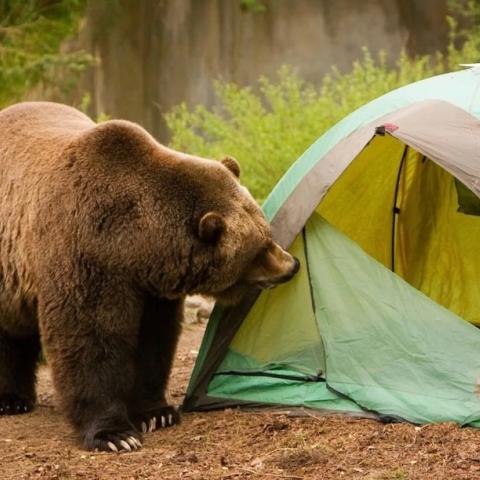
Visitors to national parks this holiday weekend are being urged to be cautious with campfires and leave fireworks at home, as fire danger is high in many parks./NPS file photo of the 1988 fires in Yellowstone National Park
Fires, fire danger, and pretty big crowds will greet visitors in some corners of the National Park System this holiday weekend, and park officials are asking for both patience and great care while you're enjoying the parks.
Fire conditions have led to restrictions in some parks in the West, and park officials remind visitors that fireworks are prohibited in the parks.
"Park fire danger is HIGH," a release from Yellowstone National Park reads. "Wildland fire managers increased the wildfire danger rating to high on Monday, June 27. High fire danger means fires can ignite easily and spread at a fast rate. Four fires have ignited in the park so far this summer. Two were human-caused and two were lightning-caused. The lightning-ignited Bluff fire started Tuesday, June 28 and is estimated to be five acres. It is burning east of Canyon Village in a remote area and will be allowed to play its natural role in the ecosystem. "
At Grand Teton National Park to the south of Yellowstone, the fire danger for the upcoming weekend also is rated as high.
"Along with the fireworks prohibition on public and county lands, campers are reminded that unattended or abandoned campfires can easily escalate into wildfires; therefore, it is important that all campfires are completely extinguished and cold to the touch before leaving a site," a park release said. "Campers and day users should have a shovel on hand and a water bucket ready for use. All campfires must be completely extinguished and cold to the touch before leaving a site.
"Visitors have abandoned 19 campfires on the Bridger-Teton National Forest and in Grand Teton National Park so far this summer. Campers should be mindful that they could be held liable for suppression costs if their campfire becomes a wildfire. Local residents and area visitors are reminded to know the risks, exercise caution, and practice heightened fire safety at all times."
In Alaska, Park Service personnel were keeping an eye on seven fires that was ignited by lightning strikes last weekend in Yukon-Charley Rivers National Preserve. The largest fire, the Kandik River Fire, had covered more than 550 acres as of Tuesday evening. It is located approximately 5 miles north of the Kandik River public use cabin and 75 miles downriver of Eagle.
In taking a monitoring approach to these fires, the Park Service explained that "fire in Alaska’s boreal forest is an essential process that restores ecosystem health and helps maintain species diversity. Both black and white spruce depend on intense ground fire to clear organic layers thereby exposing fertile seedbeds. Black spruce particularly depends upon fire, as its seeds are ready for germination at the peak of the interior Alaska fire season, and are released when canopy fire opens its semi-serotinous cones. Fire also plays a key role in the regulation of the permafrost table.
"Without the routine occurrence of fire, organic matter accumulates, the permafrost table rises, and ecosystem productivity declines. Vegetation communities, wildlife habitat and wildlife become less diverse. Fire as an agent of change maintains and rejuvenates these systems."
In the Olympic Peninsula of Washington state, Park Service and U.S. Forest Service officials were reminding visitors that "possessing, discharging, or using any kind of firework or other pyrotechnic device on federal public lands is prohibited year-round, regardless of weather conditions or holidays."
At Yosemite National Park in California, officials warned travelers that the park likely would be extremely crowded this weekend.
"Visitors are urged to arrive at the park very early to avoid potential traffic congestion and difficulties with parking. Visitors should plan on arriving at the park entrances by 9 a.m. each day," a park release said. "Parking in Yosemite Valley is expected to be especially challenging and visitors should plan accordingly. Based on past holiday weekends, visitors arriving during peak hours have been delayed for up to two hours in east Yosemite Valley. The park has added approximately 300 new parking spaces west of Yosemite Lodge. However, delays are still expected during the peak times."
Yosemite visitors also were encouraged to take advantage of the free shuttle bus service in Yosemite Valley. Additionally, the park noted, the Yosemite Area Regional Transportation System (YARTS) is a great way to get to the park. YARTS brings in visitors from Highways 120 West, 120 East, 41, and 140 corridors. Once in Yosemite Valley, visitors have a seamless transition to the park shuttle buses. For a schedule of routes and times, please consult this website.
Yosemite Visitors are also urged to explore other areas within the Yosemite region. There are many areas of natural beauty and cultural significance surrounding the park. A variety of attractions in and around gateway communities such as Mariposa, Oakhurst, Sonora, Lee Vining, and Mammoth Lakes offer great hiking and sightseeing opportunities.
As with other units of the National Park System, fireworks are strictly prohibited in Yosemite. "Additionally, with the ongoing drought, conditions are extremely dry and visitors are asked to avoid campfires unless absolutely necessary," a park release said.
Visitors should also be mindful of the expected warm temperatures this weekend. They should drink plenty of fluids, avoid strenuous activity in the middle of the day, and be careful of overexertion. Watch for signs of heat stress and do not leave pets or children unattended in vehicles.
All campgrounds within Yosemite National Park on the reservation system are sold out through the Fourth of July weekend. There are a very limited number of first-come, first-served campsites within the park and those are expected to fill early. For 24 hour road and weather information, call 209-372-0200.




 Support Essential Coverage of Essential Places
Support Essential Coverage of Essential Places







Add comment